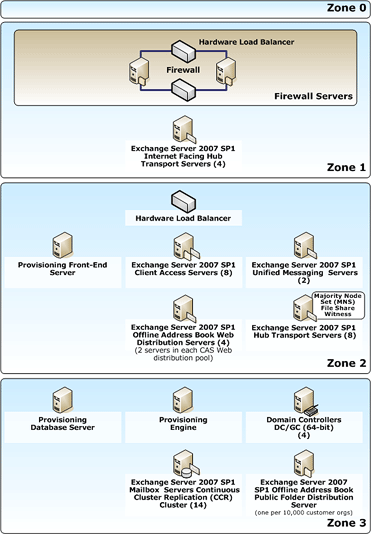The Upper Tier architecture is designed to support more
than 20,000 active MAPI mailbox users but less than 100,000 active
MAPI mailbox users. It includes both dedicated servers, and servers
running more than one role:
- Ten servers running Client Access roles
- Two servers running Unified Messaging roles
- Eight servers running Hub Transport services
- Four external internet facing Hub Transport servers
- Twelve cluster continuous replication (CCR) clusters (a total
of 24 physical servers)
 Note: Note: |
| Customers looking for a lower total cost of ownership (TCO),
lower service-level agreement (SLA) solution could run 14 local
continuous replication (LCR) servers instead. Customers who have
already invested in traditional multinode, single-copy clusters
could continue to use this method of clustering. |
- Four Active Directory Domain Controllers
- Two separate CAS servers for web based OAB
distribution
- One Public Folder OAB server for every 10,000 hosted
organizations (for how to increase the maximum number of OABs on a
OAB server to 10,000, see KB
article 945629.)
 Note: Note: |
| Upper Tier is more designed toward 100,000 concurrent MAPI
users, assuming a heavy usage profile. |
 Note: Note: |
| Actual MAPI users supported by the system could be
significantly higher, depending on the level of concurrency. For
example, if in average, 10% concurrent MAPI users are active, the
actual Upper Tier architecture can support up to one million MAPI
users (1,000,000*10%=100,000). |
 Note: Note: |
| Scalability is largely dependent on the protocol mix (for
example, the percentage of Outlook Anywhere, Outlook Web Access,
POP, IMAP) and the user’s usage profile. The recommendation is
based on heavy usage profile. |
The following figure shows the architecture for an
Upper Tier deployment.

 Note:
Note: Note:
Note: Note:
Note: Note:
Note: